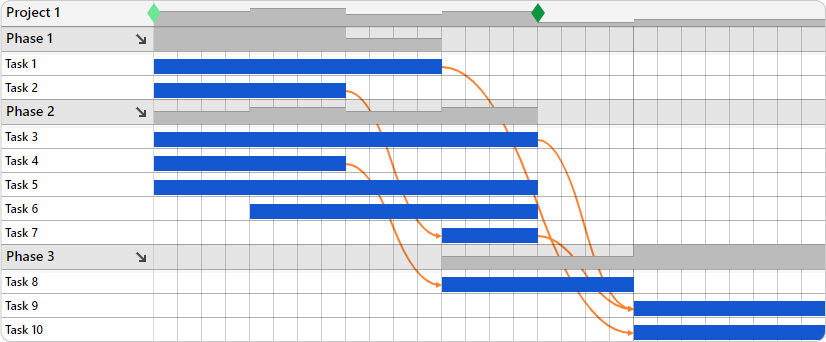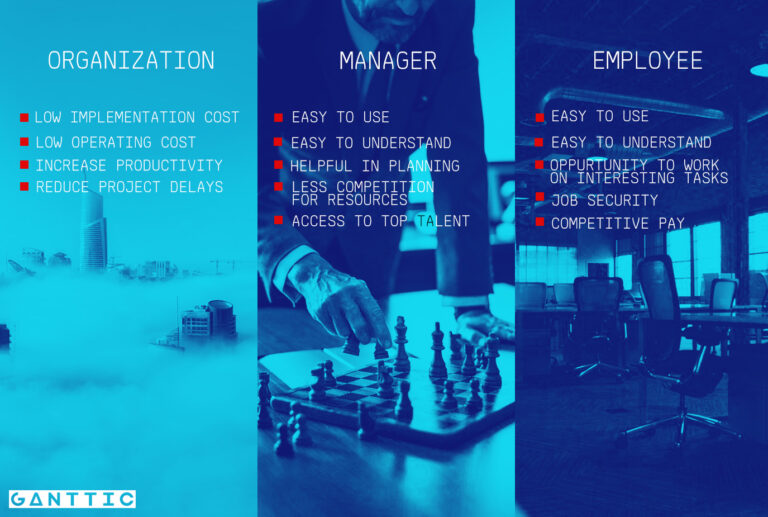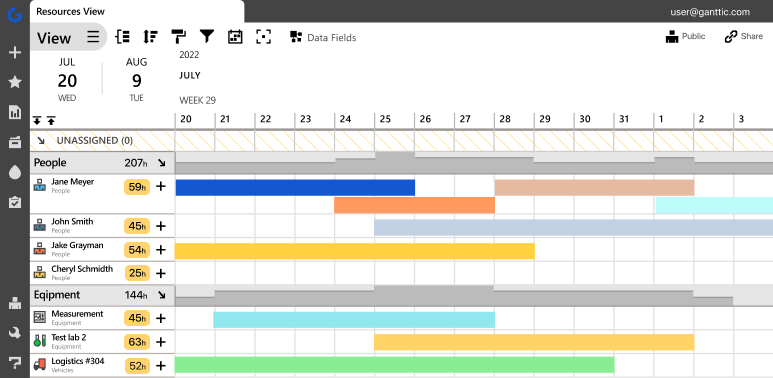In the whirlwind of today’s business world, mastering project management and resource optimization is the key to whizzing ahead of the competition. Which is why more project managers are turning to the principles Project Portfolio Management (PPM). A technique that when compared to singular project management, creates a more holistic perspective to the ever-evolving and fluctuating projects lined up in your calendar. This strategic powerhouse aligns project investments with organizational objectives and can help in supercharging success.
In this article, we’ll delve into the inner workings of a robust project portfolio management process and unveil the undeniable benefits it brings to businesses.
Get ready to harness the potential of PPM and propel your organization towards new heights of achievement!
What is a Project Portfolio Management Process?
Project portfolio management is a systematic approach to prioritizing, organizing, and controlling an organization’s projects and activities in order to achieve specific business objectives. As opposed to single project management, the PPM process is continual and often rigorous. As it involves evaluating potential projects, selecting those that align with the organization’s strategic goals, and allocating resources efficiently to deliver maximum value.
The bad news? According to a survey, only 33% of project portfolio managers would categorize the PPM practices at their organization as highly effective. And 62% of managers estimated the practices to be mediocre. While 5% say its essentially nonexistent in their organization.
What’s even scarier, the ones that perceived their project portfolio management process to be highly effective, also stated they often experience significant delays at the project level. And why is that important? Well without one, your organization is missing out on some proven methods of improvement.
Benefits of an Strategic Project Portfolio Management Process
What’s the point of embarking on a PPM process? Well, implementing one offers several key advantages to organizations big and small. Such as:
Organizational Alignment = Better ROI
PPM ensures that all projects within the portfolio are aligned with the organization’s strategic goals and objectives. This is done by by allocating resources to those activities that contribute the most to the overall success of the business. Meaning with one in place, you’ll see a better ROI on the projects you’re hoping to deliver. Which at the end of the day means your business will be running more lean and seeing more green.
Improved Decision-making
With a strategic PPM system in place, you’ll have a more structured framework when delving into the decision making process. That means when it’s time for evaluating project proposals, making tough choices, and optimizing resource allocation – there’s already a plan in place. What does this mean for your own company? Well, it a PPM process, organizations are better equipped to select the right projects for what comes next. Along with the ability to make more data-driven decisions, which help to maximize returns.
Less Resource Wastage
In the realm of strategic portfolio management, a remarkable transformation awaits. By delving into the depths of resource allocation, organizations gain the power to unlock efficiency, eliminate waste, and optimize every ounce of potential.
That’s because PPM enables efficient resource allocation by considering all the factors and looking at the bigger picture. This includes the organization’s capacity, employee skill sets, and project demands. Prepare to witness remarkably less resource conflicts and better alignment with project demands. And get ready to maximize resources and minimize waste like never before!
Risk Mitigation
PPM is a continuous process, but don’t let that scare you away! Through continuous monitoring and evaluation, it will help identify and address potential risks earlier in project cycles. In turn this allows organizations to proactively manage risks and take necessary actions to mitigate these impact on their projects’ goals.
Enhanced Communication and Collaboration
A well-defined PPM process encourages collaboration among project teams, stakeholders, and senior management. By having and improving upon communication channels, you’ll see that your organization can begin to foster transparency and facilitate knowledge sharing. All the while enhancing overall project performance.
Better Adaptability to Change
PPM provides organizations with the agility to adapt to change. And in today’s fast-moving business landscape such a change management skill is key. By carefully evaluating market conditions, priorities, and customer demands organizations set up for more success. And with a clear-cut process in place it can enable them to reprioritize projects, reallocate resources, and make timely adjustments to maintain a much-needed competitive edge.
The Process of Project Portfolio Management
What are the steps you need to take to undergo a PPM revolution at your own organization? Here’s a cheat sheet of what it takes:
1. Identify and Categorize Projects
The first step in the PPM process is to identify and categorize potential projects.
This often involves compiling prospective projects and proposals from various sources. Be it stakeholders, departments, or individual teams. From there, you can start assessing their feasibility, and decide whether or not they align with the overall strategy and priorities.
To do this, try grouping projects into different portfolios based on different initiatives or areas of your organization. For example, operational efficiency, customer experience, or market expansion.
Pro Tip! In Ganttic you can create an unlimited number of private or personal Views. A View helps to segment the entire portfolio by filtering out any extras. Create a View of projects that your manufacturing team in Location 1 is working on. Compare this with singular Views of Locations 2 and 3 by then creating an All Project View of the entire portfolio.
2. Evaluate Project Selection
Once projects have been identified, they need to be evaluated based on various criteria. This may include whether they “fit” the overall strategy, financial viability, resource requirements, and risk analysis and potential ROI. This evaluation process helps decision-makers select the most promising projects that align with the organization’s goals.
3. Allocate Resources
After the projects are selected, the next step is to deciding whether you have the resource capacity available to carry them out. For resource allocation in portfolio management to be successful, a thoughtful determination of the the required workforce, budget, equipment, and other necessary resources for each project must be conducted. In order to do this, organizations need to allocate resources effectively to ensure successful project execution. Considerations need to be made that the optimal utilization is reached in order to prevent overburdening employees. While also ensuring that the right tasks are going to the right resources.
4. Project Prioritization and Sequencing
Prioritizing projects is crucial to ensure that resources are allocated to the most critical initiatives. By sequencing projects based on their importance, dependencies, and available resources, organizations can streamline project execution and minimize bottlenecks.
 Project phases and sequencing done in Ganttic.
Project phases and sequencing done in Ganttic.
5. Performance Monitoring and Control
Throughout the project lifecycle, continuous monitoring is essential to track progress, identify potential issues, and take corrective actions. Key performance indicators (KPIs) are established to measure project performance, and regular status updates are communicated to stakeholders.
6. Portfolio Review and Decision-making
Periodic portfolio reviews enable organizations to assess the overall health and progress of projects. It involves reviewing key metrics, evaluating risks, and reaching informed decisions about continuing, modifying, or terminating projects. Reports and regular meetings can ensure the portfolio remains aligned with changing business priorities.
Take a tour of Ganttic to see our key features that will enhance your own PPM. Or book a demo to learn more.
Roadblocks to an Effective Project Portfolio Management Process
Before we get to suggesting improvements, let’s take a look at current project portfolio management practices and some roadblocks to their success. As one scholar from MIT made it their mission to understand and improve this area.
These include:
High uncertainty
The majority of projects are executed in a multi-project environment where uncertainty is considered the normal state. There isn’t a plan B. And there isn’t a need for a plan B since more often than not, resource schedules stay unchanged after they are first set. And it should be alarming since portfolio rebalancing is one of PPM’s foundational tasks.
Homogenous portfolios
Most organizations report combining new development and sustaining projects in the same portfolio but tend not to mix internal and external projects. While the first can be categorized as a good practice since it’s positively correlated with the perceived proficiency of the project portfolio management. There’s a clear decrease in perceived proficiency when internal and external projects get mixed up in the same portfolio.
Small project portfolios
Another thing that seems to be popular is how many projects make up a portfolio. According to the survey, most participants said to have at least five projects in a portfolio and over 50% of them said to maintain at least ten concurrent portfolios. The relationship between the ration of projects-to-portfolio and proficiency indicates there’s a strong reason to minimize the number of project in a portfolio and maximize the number of portfolios.
Reactive resource planning
If we get to allocating resources, we see that it’s still something that is done rather erratically and reactively than systematically. The typical resource management process seems to be following: as the effort needed increases, management can either increase the work intensity, encourage employees to work overtime or add more resources through hiring.
Burning up productivity
Working faster or more efficiently and overtime tires the resources and reduces productivity in the long run. When more resources are hired, the company’s experience diminishes through the time needed for onboarding and ramp-up which also lowers the productivity. It seems that any option to decrease the workload will convert into the company losing money and paying employees who aren’t productive.
Perceived efficiency
Those that involve employees in the resource planning process seem to perceive their PPM process to be more effective than others. The most interesting part of it is that there wasn’t a correlation between the size of the organization and the perceived efficiency of the portfolio. So while it might seem obvious that it’s easier to involve employees for startup rather than a large enterprise, that’s simply not the case. And there actually is a for both to do it effectively.
Steps to Improving Your Own PPM Process
In project-based organizations, the resources are what offer the competitive and financial edge. Effective resource management should be viewed as a way to take care of those resources. And managers should be the carriers of these practices rather than someone out for their own interests.
Luckily, these value-action conflicts can be reduced by aligning the expectations using resource management, so the actions made would serve the same goals. The goals of the organization. Here’s a few steps on how to improve your own organization’s PPM.
1. Make the PPM Process Continuous
Neither project portfolio management nor resource management can be “do it once and it’s done” kind of a job. There has to be balancing, there has to be reallocating. It can’t be always post hoc. Meaning after the initial scheduling, the planned tasks and allotted resources should be revisited.
When PPM is more idle than circular, managers create a situation where resources are booked “just because.” There’s no consideration for other factors. And things like task duration is estimated using its complexity, risk, and historical performance, as opposed to how quickly a booked resource can manage it.
However, when the resource is not a right fit, this can cause problems which tend to build and bubble over. When that happens, dependent projects and tasks may need to be moved. And if they aren’t, there will be an unnecessary delay that could collapse the entire strategy.
A way to reduce this potential problem is by keeping information systems steady and up to date. For example by simply mapping out the skills of resources, you’ll immediately see a clearer picture of the current state of your workforce. This also gives you a roadmap on areas where further improvements can be made. For example, in the next hiring period should more people with a specific skill set or certification be onboarded? Who are the people and resources you need to accomplish the next phase or set of projects?
 A simple skills matrix can considerably improve your PPM process and decision-making.
A simple skills matrix can considerably improve your PPM process and decision-making.
Read more about using custom data in your resource management software. With them you can build a skills management strategy that complements rather than complicates your project portfolio.
2. Build a Cancellation System
If there are no cancellation policies when scheduling resources, managers tend to become excessively risk-averse and will not make decisions until the uncertainty is low enough. Which might even sound like a good thing.
In reality, it’s nothing other than holding in information that could help other managers during planning. If there were cancellation policies in place, managers could take calculated risks and plan in advance considering the available information. Again, if the schedules made on certain uncertainty are revisited, and resource are reallocated after new information surfaces, it won’t harm the portfolio.
Another way to tackle holding in information is encouraging creating backup plans. Planning using different what-if scenarios, and making sure other managers know what the scenarios are, so they could create their own interdependent backup plans.
Pro Tip! In Ganttic’s Views you can draft different scenarios of the projects. Making it easier to strategize potential outcomes while ensuring projects’ success.
3. Involve the Employees
Perhaps the most important part of it all is making sure every stakeholder would have an access to the same information. Meaning every manager should be able to access and update the same set of online Gantt charts or any other tool you use to manage the portfolio. When talking about continuous resource management cycle, it can’t work if every manager is still working on their own resource planning spreadsheets. It has to be a collaborative system.
Moreover, it’s not only the managers that should be able to access the schedule. If you want your employees to be more engaged and productive, they should be involved in the resource booking process. Consider project portfolio management tools that don’t charge per user, if inviting all the employees wouldn’t be cost efficient with your current software. If confidentiality is an issue, use different user rights and create different sets of access.
If the access is granted, take a step further and give the resources an actual say on the planned task duration, and maybe even the task planned for them. In addition to or instead of giving out monetary rewards, build a system where a top performing employee can choose the tasks they want to complete.
After all, including employees in the resource management process seems to be what makes PPM practices more efficient.
4. Manage Expectations
When talking about best practices for PPM, everyone has different goals and expectations in mind. And often what’s best for one party isn’t the best option for the other players.
While for managers and employees simplicity seems to be the key, organizations opt for the lowest cost. Employees want management practices to bring them interesting tasks, and managers want the process to be helpful while planning, the organization’s aim is to increase productivity. While managers don’t want to compete for resources, the employees don’t want to compete to keep their jobs. And the organizations just aim to reduce project delays.

For example, imagine a situation where each manager is trying to get the best resources for their projects which can cause overutilization of certain resources and leave other dormant. If one manager has a control over too many portfolios, their preferred resource management practices take a toll on the other resources. There’s both less competition for them and an access to top talent.
Ganttic for PPM
 Ganttic is an online tool perfect for project portfolio management.
Ganttic is an online tool perfect for project portfolio management.
When it comes to effective PPM, having the right tool in your arsenal is crucial.
With its user-friendly interface, robust resource management capabilities, and comprehensive reporting Ganttic is up to the challenge of meeting the diverse needs of your organization’s project portfolio management.
The cloud-based tool provides a seamless experience, allowing organizations to visualize and track multiple projects simultaneously, optimize resource allocation, and prevent overallocation. With interactive Gantt charts, customizable timelines, and collaboration features, Ganttic enhances teamwork and streamlines project workflows. The flexible reporting and analytics capabilities enable data-driven decision-making, while customizable reports offer valuable insights into project performance and portfolio health.
Ready to revolutionize your project portfolio management? Harness the power of Ganttic and unlock success today! Don’t miss out on the opportunity to drive your organization towards greater efficiency and achieve your strategic objectives. Sign up for a free trial and see the difference for yourself!
The article and the illustrative material is based on Mina Botros Masters thesis on human resource management in project portfolios.